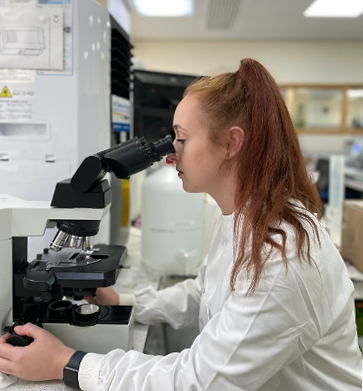How I felt starting my placement and the advice I would give to others
My placement was in the Cellular Pathology department at University Hospitals Sussex Pathology East. When I started I felt excited to have the opportunity to apply the knowledge and skills gained from the first two years of studying Biomedical Science BSc(Hons) in a professional clinical setting. I was keen to delve into the variety of different diagnostic tests carried out in the hospital to gain a better understanding of what a practicing biomedical scientist does. However, I felt nervous about the step up in responsibility and autonomy that comes with working in the healthcare setting. I was also worried about the amount of work that would be required to complete the registration training portfolio whilst working full time.
I would advise placement students to make use of the online resources available from the Institute of Biomedical Science (IBMS), since these give a really good in-depth explanation of what the registration training portfolio entails. Engaging with the university module also really helped with breaking down the portfolio to understand each of the modules. I would also advise students to try to arrange a lab tour prior to their start date, to give them an understanding of what to expect on their first day. This definitely helped to ease my nerves! I’d also advise students to not be afraid to ask for help throughout the year since all laboratory tests affects the patient, and as a biomedical scientist you must know your scope of practice. My final bit of advice, and perhaps the most important, is to enjoy the experience, there is so much to gain from the year!
Highlights and challenges
One of the highlights of the placement was completing the IBMS registration training portfolio. This involved creating 30 pieces of evidence to demonstrate that I have the competence and knowledge required to practice safely and effectively in a diagnostic laboratory. I spent the year in the cellular pathology department and one of the evidences required me to witness the specimen collection. This involved attending theatres to observe a head and neck dissection for a squamous cell carcinoma case, the tissue of which is sent for processing in the cell path lab. This experience was extremely insightful and highlighted where biomedical scientists fit into the patient’s care.
One of the challenges of the year was completing the portfolio and university assignments whilst working full time. This can seem really daunting at first, but with good time management and organisational skills it is completely manageable. I found that creating weekly timetables to dedicate time to completing evidences ensured that I kept on top of my workload. Scheduling meetings with my training officer to keep track of my progress and to set goals really helped too. It’s also a good idea to made use of the study leave that is included in the placement year contract, and made sure to schedule this leave to benefit upcoming deadlines.
The placement module supported my journey by signposting the key learning points for each of the modules in the registration training portfolio. The module booklets made understanding the content of each module easy and enjoyable, and the group work was a really engaging way to learn. We wrote reflection-based evidence about our own practice to identify what we are doing well and things we could improve on, which helped us to understand the requirements set out by the IBMS. The module booklets were also great to help you to think of what other evidences to create for the portfolio.


What is a viva and how did I prepare for it?
A viva is a form of oral examination that is carried out in the laboratory after completion of the registration training portfolio. This comprised of interview style questions about the year, followed by a 30-minute laboratory tour. The tour involved showing the verifier around the lab whilst explaining various health and safety, COSHH, PPE, quality control and procedural steps we must acknowledge in a diagnostic lab. This sounds scary but after working there for a year this information will have become routine! The IBMS verifier also looks through your portfolio and you will be passed or failed.
To prepare for my viva, I did a few mock lab tours with my training officer and other biomedical scientists to get some feedback before the real thing. This helped to ensure I was covering the most important points and meeting the required depth for all areas of the lab. It can be nerve racking preparing for the viva but everyone will be rooting for you!
Looking to the future
In the next 5 years I hope to be working as a biomedical scientist in an NHS cellular pathology laboratory. I hope to have completed the next IBMS portfolio, the specialist portfolio and be working towards a master’s degree. I also hope to be training in specimen cut up to work towards a dissection portfolio.

Published by